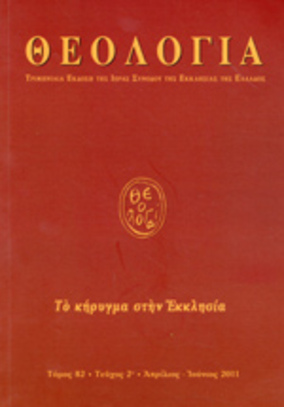Ὑπῆρξε ἡ ἑορτὴ τῆς Concordia (5 Φεβρ.), ήμερα εκδόσεως του «Διατάγματος του Μεδιολάνου»; : (Διπλωματικές πρακτικές μιας πολιτικής - θρησκευτικής παράδοσης)
Part of : Θεολογία : τριμηνιαία έκδοση της Ιεράς Συνόδου της Εκκλησίας της Ελλάδος ; Vol.83, No.3, 2012, pages 321-353
Issue:
Pages:
321-353
Parallel Title:
Was the feast of Capitolian Concordia (5 Feb.), the exact day when the edict of Milan was issued? : (Diplomatic practices of a political-religious tradition)
Author:
Abstract:
I f really the emperor Constantine had met Licinius in Mediolanum/Milan in the beginning of February (313) -as it is accepted by the greater number of the historians-, simultaneously celebrating the wedding (or engagement) of his sister with his co-emperor, he had not more to do either the treaty with him or the subscription the edict of religious tolerance in an important day: the feast of Capitolian Concordia (5 Feb.), a familiar-connubial deity as well as tribal-political of the republican and imperial Rome. It is known from the work of Theomnestos (Hippiatrica Berolinensia 34.12) that Licinius departed from Carnuntum to complete a frenzied hiding under snowy weather to Mediolanum about the beginning of February. The same act did Julian in 362, 4 Feb., when he issued an homologous edict, related to the rights of the polytheists. In this case Concordia according to an old roman tradition for the political peace brought a ritual solution to the civil kind of war, the persecutions against Christians, which had started ten years ago, from 303, 23 February. The first step of the peace was the liberty of the roman people, when Maxentius was defeated in the Mulvian bridge (312, 28 October, the day of the anniversary of his Lustrum) and afterwards in Mediolanum, in a similar day, that is 313, 5 February. It is obvious that, if Constantine made or accepted war in the anniversary of his enemy, he could more easy to do a peaceful deed. This suggestion about the exact day which changed the roman world -and because of that event must be important-, is not difficult to be accepted, if we consider the logic of the imperial secretariat, which selected analogous days, for the necessary imperial propaganda. So, we believe that there was a specific use of the religious-national tradition of the Romans, when feasts with a special symbolic meaning and reference are renovated in their dynamic by the Romans in order to take new decisions, to legislate new laws etc. The two emperors of East and West in Milan had to take a great decision to stop the persecutions. This is the reason why it was happened in a very important day, as it was similar importance the starting of the persecutions (23 February 303, the day of the feast of Terminalia) as well as the official close of the persecutions (313, 13 June, in the Idus Junii, a day belonging to the honour of Jupiter; or, in the case of emperor Galerius who stopped his persecution in 311, 30 April, the day of Floralia and contemporaneously his Lustrum. The same logic is pick up in the civil policy of Augustus, which dedicated temples, or made public events in the days of the anniversaries of his family. Also, Constantine will imitate it later in the case of the consecration of Constantinople (324, 8 Nov., in the feast of Mundus Patet), or in the foundation (330, 11 May, the day of Lemuria), both being feasts of the Dead, and also in the case of the church of Resurrection in Jerusalem which was dedicated in 335, 13 September, the day of Idus Septembris and the dedication of Jupiter in Capitolium. This practice was a kind of the ritual upon the political praxis of a Roman leader, but in the case of Constantine, who practiced a neutral religious policy -in Milan’s edict even the same God of the Christians officially was a simple divinitas-, avoiding the sacrificies and even the Ludi Saeculares, or using representational artistic forms with symbolic meaning. Besides of the happy end of the persecutions, the same Concordia as familiar day coincided with the consecutive marriage of Constantines sister with Licinius (in any case not in 5th of February, because it was forbidden to do marriages in such a day) the first between the families of the Tetrarchs, in order to be the roman state under the supervision of two relative by marriage families. The next step of Constantines policy after 324 was to bring the state affairs under the authority of one family, his own family. The historical importance of the agreement of such a day with symbolic meaning would be intermediary to a new world which would by-pass the religious paganism with the new use of a few traditional roman virtues as Libertas (28 ctober 312) and Concordia, for a more united roman state - from 297/98 united with a unique administrative system of c. 100 provincesand also from 1st September 312, with a united financial system, that is of indictiones. That is why Concordia was an emblematic political idea in the mind of Constantine, but obviously in the members of his secretariat.
Subject:
Subject (LC):




